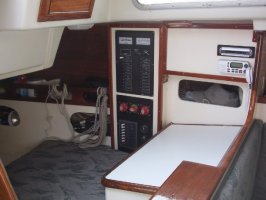E-35 II DC Panel
Glynn,
After ripping almost all the wire (AC and DC) out of my '72 E-35 MKII, I'm planning on a new DC panel installation that will bring the boat up to the 21st century. The AC system is complete with all new tinned wire combined with Blue Sea Systems #8029 (Mains with polarity) and an 8 position AC sub-panel with volt and amperage gauges. Now there are GFCI outlets in convenient locations, the battery charger meets code and the old AC fire hazard wiring is gone!
The new AC panels are all mounted near the original DC panel over the ice box area. Since my shore cord connection is in the stbd rear cockpit area, this made sense for the AC panels, notably the AC mains interupt. As an aside, the AC mains breaker is required to be within 3 meters of the shore cord connection (measured along the conducter), so this area made sense for the AC install (see ABYC E11.12.2.9.3). In addition, it is not recommended to co-mingle AC and DC circuits and panels as it is possible to have an arc or short circuit from AC to DC and cause a hazardous situation (more ABYC stuff).
As you are probably more than aware, the old Ericson DC panel is woefully outdated with the toggle switches and fuses, not to mention the 35 years of 'elctricians' who worked on it with a hatchet and electrical tape. So, I have speced out a new install that will mount in front of the nav station bulkhead in the area of the port aft storage shelf.
What I could never figure out is why Ericson put the batteries on the port mid-ship area and the DC panel located about 20 feet (wire run wise) away on the stbd aft mid-ships. To top it off, someone ran all the heavy battery cables to a Perko "OFF/Bat 1/Both/Bat 2" switch mounted next to the DC panel and back. I pulled out about 50 feet of red and black battery cable (untinned) from that mess. The Perko switch is now temporarily located on the Nav panel bulkhead tucked up in the outboard coner until the proposed DC panel is nearing completion.
Prior to instigating the new DC wiring, I removed the small Ericson battery box and fabricated a much larger box that now holds two GRP 31's (or two 6 V batteries if desired) instead of the designed GRP 24's. This appraoch has increased bat. capacity tremendously with little weight penalty (!) and offered the option of 6V batteries later is desired.
The area for the new DC panel is close to the current battery installation, close to the engine (and alternator), readily visible, away from water spray, not too out of the way for operation yet not in a location where someone could mistakenly fall/lean against it shutting off circuits in rough seas/bad WX.
It has been a real job stripping out all the Ericson (and added) wires to be replaced with tinned cables. I have installed temporary fuses in the DC circuits that are freshly re-wired until the main DC panel is finished. It's kinda like widening a road and keeping the traffic flowing until it's done.
Now I'm in the planning stages of making an enclosure that will be built into the last 18" of the shelf area behind the port settee and use the nav station bulkhead as the aft side of the panel's box. This way, I have plenty of room to run wires by feeding them from underneath and not crowd them or make a rat's nest. Also, the front the panel can be mounted on a hinge so it may drop down for new wiring, new breakers, maintanance or what ever. It will be totally enclosed except for the hinged front panel.
ANyway, I have decided on the Blue Sea Systems panels, the location and basic design. I just need to come up with close to $1,000 to finish off the last stage - building and wiring the panel!
I keep an eye on ebay as there are occasionally good deals on Blue Sea Systems panlels on there.
John M.



 /) /)
/) /)
 /) /)
/) /)


